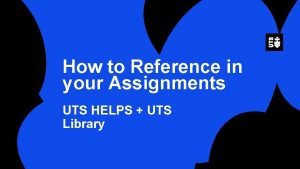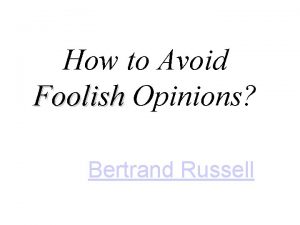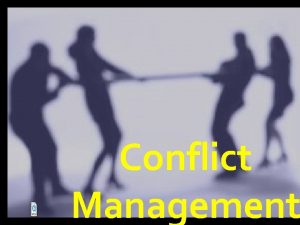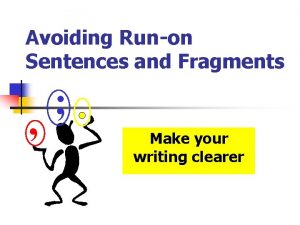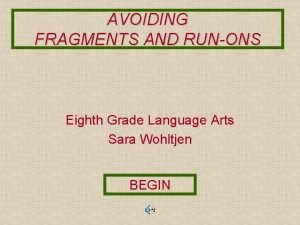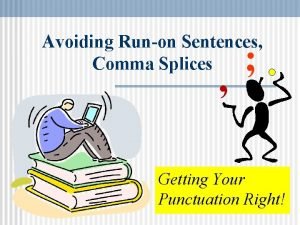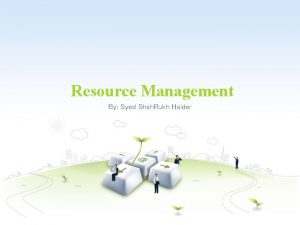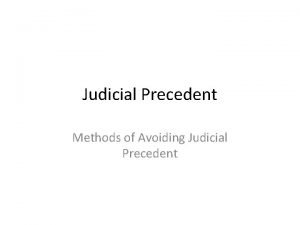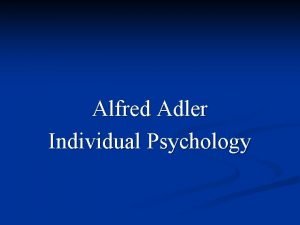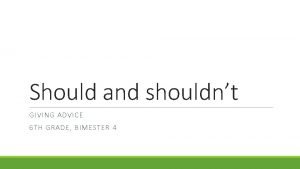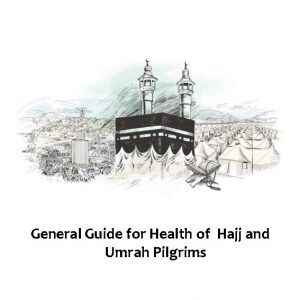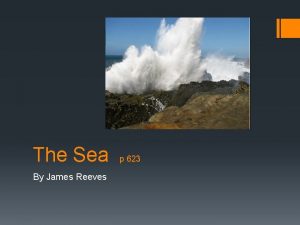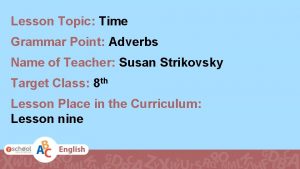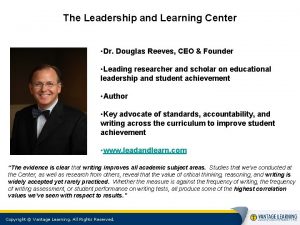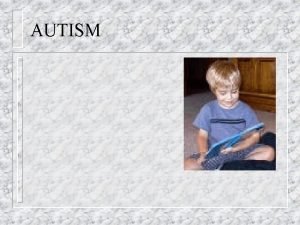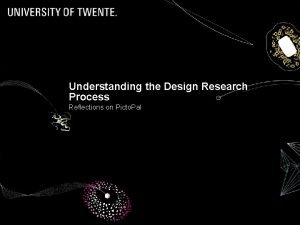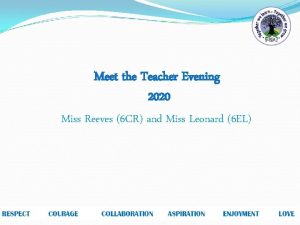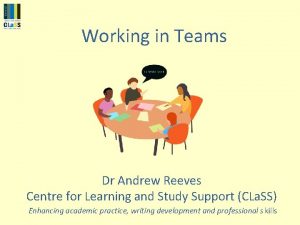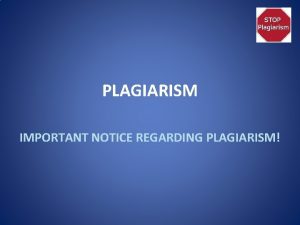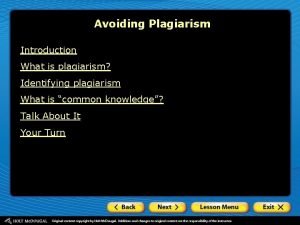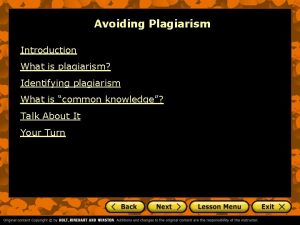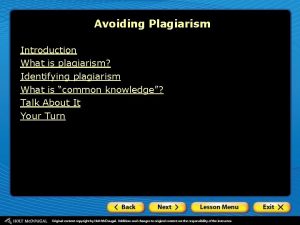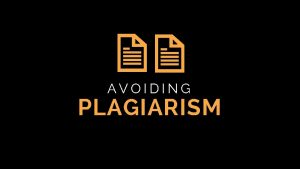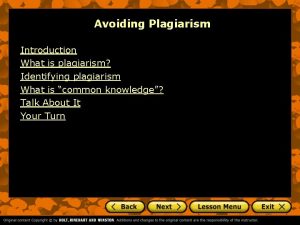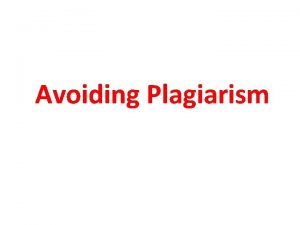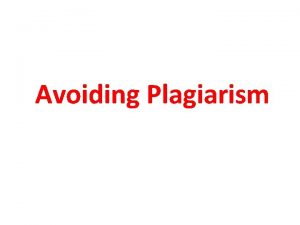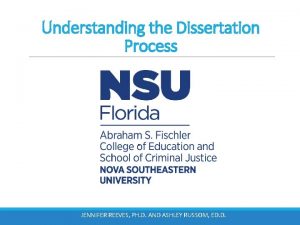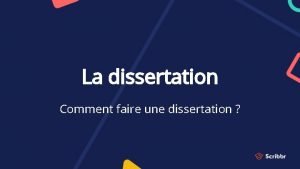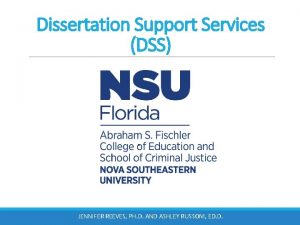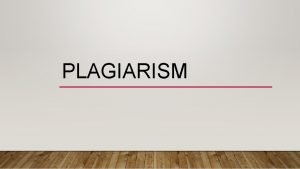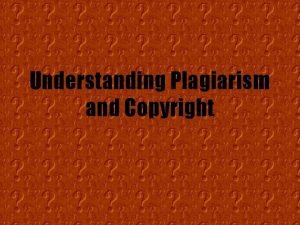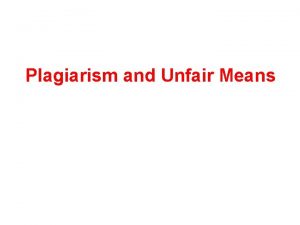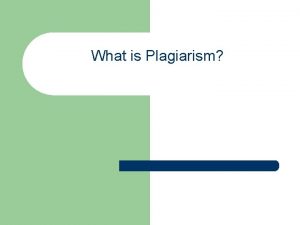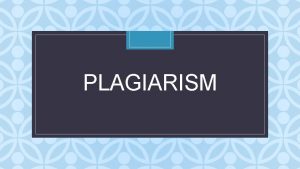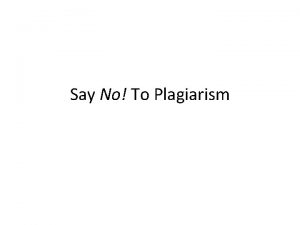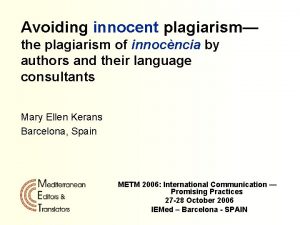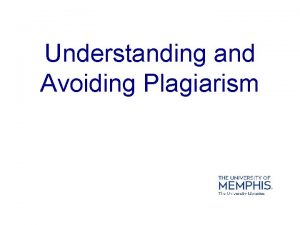AVOIDING PLAGIARISM IN THE DISSERTATION PROCESS Jennifer Reeves







































- Slides: 39

AVOIDING PLAGIARISM IN THE DISSERTATION PROCESS • • Jennifer Reeves, Ph. D. , David B. Ross, Ed. D. , • Mark Seldine, Ed. D. , and David Weintraub, Ed. D

DSS CALL TO ACTION! • Introductions • Two plagiarism cases just last month • DSS Response

I declare the following: STATEMEN T OF ORIGINAL WORK I have read the Code of Student Conduct and Academic Responsibility as described in the Student Handbook of Nova Southeastern University. This applied dissertation represents my original work, except where I have acknowledged the ideas, words, or material of other authors. Where another author’s ideas have been presented in this applied dissertation, I have acknowledged the author’s ideas by citing them in the required style. Where another author’s words have been presented in this applied dissertation, I have acknowledged the author’s words by using appropriate quotation devices and citations in the required style. I have obtained permission from the author or publisher—in accordance with the required guidelines—to include any copyrighted material (e. g. , tables, figures, survey instruments, large portions of text) in this applied dissertation manuscript.

FORMS OF PLAGIARISM

�The word plagiarize comes from the Latin plagiarius, which means “kidnapper. ” ◦ Plagiarism constitutes literary or intellectual thievery. ◦ Students and other researchers have become dependent upon the technology and have lost reason by allowing technology to take over their critical thinking to merely plagiarizing and searching for ghostwriters than researching and writing their papers, articles, and other published work (Ross, Exposito, Sasso, Matteson, & Matteson, 2019).

GHOSTWRITING • The conduct of cheating violates both federal and state felony statutes-law(s). • A person(s) or institution can be criminally charged-convicted individually or in a conspiracy case. • The Federal False Claims Act is a tool that can reign in unethical conduct and encourages the reporting of unethical conduct and violations of federal law. • Any person or institution having personal knowledge of any conduct defined by statute as illegal conduct can lead to the felony prosecution of persons and or institutions that fail (Misprision of a felony) to report any conduct which is illegal (18 USC § 4). • The 18 USC 1346 is a federal criminal statute that covers Honest Services for any conduct that leads to deception or scheme to defraud. • Under the Federal Mail and Wire Act, any person-business or other entity involved in a scheme to defraud (attempts are included) using the mail or wire systems are crimes (18 USC § 1341 and 1343).

• Students who contract with an editor or typist must provide that person with the Format Guide for the Applied Dissertation. Editors and typists must communicate with the student, not with university personnel. The university does not assume responsibility for a student's contractual agreement with an editor or typist or for the quality of the editor's or typist's work. The Fischler College cannot recommend a freelance editor, nor does it employ editors. If you require professional editing, speak first with your dissertation committee chair; ask if he or she is able to put you in touch with a former student who had success with an editor. Contact within your network of Fischler College doctoral students may also yield specific recommendations. Dissertation editors and typists may be found through a variety of other sources, including the Internet, phone directories, and college and university bulletin boards. Please be aware, however, that the skill levels of editors vary widely. If you do find it necessary to hire a nonreferred editor, ask beforehand if he or she has successfully worked on a Fischler College doctoral dissertation. If the answer is "yes, " request at least one reference so you can verify the editor’s qualifications with the Fischler College graduate; if the answer is "no, " it would be advisable to continue your search.

Once a decision is made, be sure that all aspects of the contractual agreement are clearly spelled out. For example, your edited manuscript may require substantial content changes during the final-review process. In such a case, your manuscript will need to be re-edited. Establish an understanding with your editor in regard to a procedure—and payment, if necessary—for additional work that may be required after the initial editing. Editors and typists must not make changes that affect the content of your dissertation. YOU are responsible for ensuring that the applied dissertation is correct prior to its submission to the dissertation committee. Therefore, the manuscript should be edited before the committee recommends it for final approval. Hiring an editor to prepare your manuscript does not preclude the usefulness of learning as much as possible about APA style and College of Education format requirements. Having a familiarity with style and format guidelines will help you to determine early in the process whether your editor is fulfilling his or her contractual obligations. A professionally edited dissertation gives you an opportunity to learn proper style by comparing—line by line—your final manuscript to your pre-edited manuscript. The knowledge that you gain from this exercise will be a benefit to you throughout your professional career.

Alumni mentors are not to provide any research or analysis assistance or act as a ghostwriter to any students participating in the mentoring program. They are not to provide substantial dissertation feedback, which could take away from the dissertation student’s own work and their collaboration with their dissertation chair and committee member. MENTOR/MENTE E PROGRAM Alumni mentors are not to provide any formatting, editing, or any other type of assistance for payment with any students in their mentor group. Every participant must abide by the NSU policies of ethical standards of conduct and NSU's core values. Additionally, every participant must always act in a professional manner and communicate positive perspectives orally and in writing (e. g. , email, social media, etcetera).

NSU PLAGIARIS M POLICY • Work that is submitted for credit must be the original work of the student. Any assignment that is not the original work of the student is considered plagiarized and in violation of the Code of Student Conduct and Academic Responsibility (see below). Plagiarism occurs when another person’s work, words, or ideas are represented as one’s own without the use of a school-recognized method of citation (e. g. , copied from another source such as an author or another student without properly acknowledging the actual writer/author) or when another person’s work is copied or otherwise duplicated for academic credit. Plagiarism also occurs when knowingly giving or allowing one’s own work to be copied or otherwise duplicated by another for academic credit, or when resubmitting one’s own work for academic credit (i. e. , work that has previously been submitted for academic credit).

APA PLAGIARISM POLICY 6. 01 PLAGIARISM 6. 02 SELF-PLAGIARISM • As stated in Chapter 1, "Authors do not present the work of another as if it were their own work" (p. 16). Whether paraphrasing, quoting an author directly, or describing an idea that influenced your work, you must credit the source. To avoid charges of plagiarism, take careful notes as you research to keep track of your sources and cite those sources according to the guidelines presented in this chapter (see also section 1. 10). • Whereas plagiarism refers to the practice of claiming credit for the words, ideas, and concepts of others, self-plagiarism refers to the practice of presenting one's own previously published work as though it were new. As noted in Chapter 1, "The core of the new document must constitute an original contribution to knowledge, and only the amount of previously published material necessary to understand the contribution should be included, primarily in the discussion of theory and methodology" (p. 16). Avoid charges of self-plagiarism by familiarizing yourself with the ethical standards regarding duplicate publication and the legal standards of fair use (see also section 1. 10).

AVOIDING PLAGIARISM RULE OF THUMB If you write something that leads your professor to ask who said that, or where did that come from, it needs to be cited…

• Unintentional Plagiarism occurs when students and researchers use the words or ideas of others but fail to quote or give credit, perhaps because they do not know how. When in doubt, students must check with a professor or librarian (i. e. , who knows the correct APA format). • • Some specific examples of plagiarism that may be unintentional: UNINTENTIONAL PLAGIARISM • (1) Paraphrasing poorly: changing a few words without changing the sentence structure of the original, or changing the sentence structure but not the words. • (2) Paraphrasing poorly: using words from the original that are not part of one's vocabulary. • (3) Quoting poorly: putting quotation marks around part of a quotation but not around all of it, or putting quotation marks around a passage that is partly paraphrased and partly quoted. • (4) Citing poorly: omitting an occasional citation or citing inaccurately.

When to Cite a Reference Should I Cite? Cardiff University https: //ilrb. cf. ac. uk/plagiarism/tutorial/whento 1. html Is it a Quote? Yes Use quotation marks and cite it No Is it a Paraphrase? Yes Cite it No Is it another’s idea/theory? Yes Cite it No There is no need to cite if it’s Common Knowledge or Your Own Thoughts

Stay away from direct quotes PARAPHRASING VERSUS PLAGIARISM Give your own full interpretation Use the screenplay scenario Always cite text correctly using APA style; make sure all references and in-text citations align

TEST YOUR KNOWLEDGE AVOIDING PLAGIARISM (2007). CARDIFF UNIVERSITY (HTTP: //ILRB. CF. AC. UK/PLAGIARISM/TUTOR IAL/WHATIS 2. HTML) Are the following examples of plagiarism? YES or NO 1. Copying and pasting a paragraph of text from a web site without enclosing it in quotation marks and referencing the source.

Yes. This is probably the most well known form of plagiarism. When you copy the exact words from another source you must enclose them in the quotation marks and provide a reference.

2. Using the ideas of another author without providing a reference, even if you write them in your own words.

Yes. Even if you do not directly copy the author’s words you must provide a reference when you talk about their ideas.

3. Claim work produced by another student as your own.

Yes. This is a form of plagiarism. Buying, stealing or copying a paper to produce your work is plagiarism. Collaborating with another student (unless instructed by your professor) is also plagiarism.

4. Copy a diagram or data table from a web site, providing a reference for the source underneath.

No. You can include a table, diagram or image from another source as long as you provide a reference.

5. Copy words from a book or article into your own work, but place quotation marks around them and provide a citation, including page number.

No. It is not plagiarism to copy words from another source as long as you place them in quotation marks and provide a reference with page number.

6. Include a fact or saying in your assignment which is generally known, but without providing a reference.

No. If a fact is generally well known or ‘common knowledge’ then you don’t need to reference it. (However, if what you may consider to be common knowledge may not be well known by others, you must provide a reference)

7. Incorporate text from another source, changing one or two words and providing a citation.

Yes. If you do not intend to quote directly from the source, you must write about it in your own words. Using too many words from the original source is plagiarism, even if you provide a reference.

LOG IN TO CANVAS DISSERTATION SUPPORT SERVICES

PROPOSAL PLAGIARISM CHECK & FINAL DISSERTATION PLAGIARISM CHECK ASSIGNMENTS

PROPOSAL PLAGIARISM CHECK

SUBMIT FILE

ORIGINALITY REPORTS HIGH SIMILARITY RESULT LOW SIMILARITY RESULT

PARAPHRASING A PAPER NOTED IN AN ORIGINALITY REPORT


PLAGIARISM LINKS • Power. Point presentation by Mark A. Seldine, Ed. D, Director of Student Judicial Affairs, Abraham S. Fischler College of Education Plagiarism by Dr Seldine. pdf • How to Recognize Plagiarism, a tutorial from the School of Education at Indiana University, Bloomington • Avoiding Plagiarism from the Online Writing Lab at Purdue University • Plagiarism: What It Is and How to Avoid It, by A. Michael Noll, professor emeritus at the Annenberg School for Communication, University of Southern California • "Any determination of plagiarism on a practicum or an applied dissertation (concept paper, proposal, final report), . . . may result in dismissal from the Abraham S. Fischler College of Education without the possibility of re-enrolling at any time” (Nova Southeastern University Abraham S. Fischler College of Education Graduate Catalog and Student Handbook, 2018 -2019, p. 170).

NOW AVAILABLE All students will be required to submit their Proposal and Final AD to the Plagiarism Check Assignment in the DSS Canvas course. PLAGIARISM CHECK! Students will download and review their Turnitin report, and address any areas of concern. COMING FALL 2019 Students will then upload the originality report into ADRIANA during the Proposal approval stage and again during the Final AD stage.

NEXT STEPS
 Uts in text referencing
Uts in text referencing How to avoid foolish opinions by bertrand russell
How to avoid foolish opinions by bertrand russell On formalizing fairness in prediction with machine learning
On formalizing fairness in prediction with machine learning Fox conflict style
Fox conflict style Run on sentences game
Run on sentences game Avoiding insider trading training
Avoiding insider trading training Avoiding fragments and run-ons
Avoiding fragments and run-ons Different positions nursing
Different positions nursing Glencoe health chapter 12
Glencoe health chapter 12 Owl fox teddy bear shark turtle
Owl fox teddy bear shark turtle Avoiding run on sentences
Avoiding run on sentences Techniques for avoiding resource overload? *
Techniques for avoiding resource overload? * Methods of avoiding precedent
Methods of avoiding precedent Theory of adler
Theory of adler What's the best strategy for avoiding atm fees?
What's the best strategy for avoiding atm fees? Complete the introduction giving advice on avoiding
Complete the introduction giving advice on avoiding Avoiding the sun
Avoiding the sun A national policy of avoiding involvement in world affairs
A national policy of avoiding involvement in world affairs The sea poem by james reeves analysis
The sea poem by james reeves analysis Slowly the tide creeps up the sand
Slowly the tide creeps up the sand Jennie reeves radiographers agency
Jennie reeves radiographers agency Dr douglas reeves
Dr douglas reeves Keanu reeves
Keanu reeves Keanu reeves
Keanu reeves Kenney reeves
Kenney reeves Miss reeves
Miss reeves Dr andrew reeves
Dr andrew reeves Hình ảnh bộ gõ cơ thể búng tay
Hình ảnh bộ gõ cơ thể búng tay Bổ thể
Bổ thể Tỉ lệ cơ thể trẻ em
Tỉ lệ cơ thể trẻ em Chó sói
Chó sói Thang điểm glasgow
Thang điểm glasgow Alleluia hat len nguoi oi
Alleluia hat len nguoi oi Môn thể thao bắt đầu bằng từ đua
Môn thể thao bắt đầu bằng từ đua Thế nào là hệ số cao nhất
Thế nào là hệ số cao nhất Các châu lục và đại dương trên thế giới
Các châu lục và đại dương trên thế giới Công thức tính thế năng
Công thức tính thế năng Trời xanh đây là của chúng ta thể thơ
Trời xanh đây là của chúng ta thể thơ Mật thư anh em như thể tay chân
Mật thư anh em như thể tay chân
